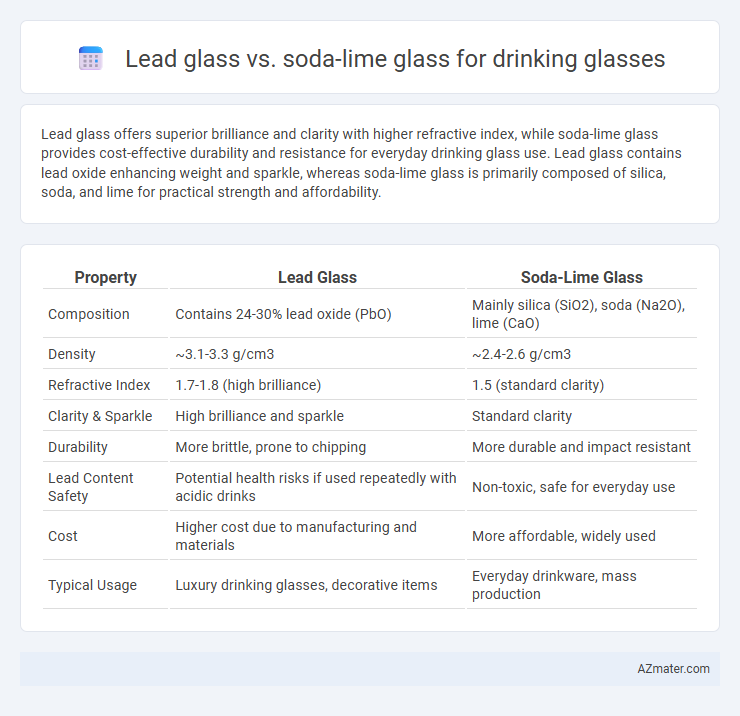Lead glass offers superior brilliance and clarity with higher refractive index, while soda-lime glass provides cost-effective durability and resistance for everyday drinking glass use. Lead glass contains lead oxide enhancing weight and sparkle, whereas soda-lime glass is primarily composed of silica, soda, and lime for practical strength and affordability.
Table of Comparison
| Property | Lead Glass | Soda-Lime Glass |
|---|---|---|
| Composition | Contains 24-30% lead oxide (PbO) | Mainly silica (SiO2), soda (Na2O), lime (CaO) |
| Density | ~3.1-3.3 g/cm3 | ~2.4-2.6 g/cm3 |
| Refractive Index | 1.7-1.8 (high brilliance) | 1.5 (standard clarity) |
| Clarity & Sparkle | High brilliance and sparkle | Standard clarity |
| Durability | More brittle, prone to chipping | More durable and impact resistant |
| Lead Content Safety | Potential health risks if used repeatedly with acidic drinks | Non-toxic, safe for everyday use |
| Cost | Higher cost due to manufacturing and materials | More affordable, widely used |
| Typical Usage | Luxury drinking glasses, decorative items | Everyday drinkware, mass production |
Introduction to Lead Glass and Soda-lime Glass
Lead glass contains lead oxide, which enhances its density, brilliance, and refractive properties, making it a premium choice for decorative and drinking glasses. Soda-lime glass, the most common type used in drinkware, is composed primarily of silica, soda ash, and lime, offering durability and cost-effectiveness. The distinct chemical compositions result in differing clarity, weight, and handling characteristics ideal for various drinking applications.
Chemical Composition Differences
Lead glass contains a significant percentage of lead oxide (PbO), typically ranging from 18% to 40%, which increases its density and refractive index, giving it a distinctive brilliance and weight compared to soda-lime glass. Soda-lime glass is primarily composed of silica (SiO2), soda (Na2O), and lime (CaO), with minor amounts of other oxides, resulting in lower density and durability than lead glass. The lead oxide in lead glass enhances its chemical and physical properties, making it less resistant to alkali attack and slightly more soluble, whereas soda-lime glass offers better chemical stability and is more commonly used for everyday drinking glasses.
Manufacturing Processes Compared
Lead glass manufacturing involves adding lead oxide to the silica mixture, increasing density and refractive index, resulting in a more brilliant and heavier glass ideal for luxury drinking glasses. In contrast, soda-lime glass is produced by melting silica with soda ash and lime, creating a more cost-effective and durable material commonly used for everyday drinkware. The higher melting temperature and precise lead oxide incorporation in lead glass require specialized furnace conditions and longer cooling times, distinguishing it from the faster, lower-temperature soda-lime glass production process.
Visual Appearance and Clarity
Lead glass boasts superior visual clarity and brilliance due to its high refractive index, creating a sparkling effect ideal for elegant drinking glasses. Soda-lime glass, while more common and affordable, has lower clarity and brilliance, often appearing slightly duller or cloudier. The enhanced transparency and light dispersion of lead glass make it the preferred choice for showcasing vibrant beverages.
Durability and Strength Factors
Lead glass exhibits higher durability and strength due to its lead oxide content, which increases weight and resistance to impact, making it less prone to chipping compared to soda-lime glass. Soda-lime glass, composed mainly of silicon dioxide, sodium oxide, and calcium oxide, is more prone to scratches and breakage under stress but is cost-effective and widely used. The denser atomic structure in lead glass contributes to better mechanical strength, while soda-lime glass is more susceptible to thermal shock and mechanical wear over time.
Health and Safety Considerations
Lead glass contains lead oxide, which can leach into beverages over time, posing health risks such as lead poisoning, particularly if used frequently or for acidic drinks. Soda-lime glass, composed primarily of silica and soda, is non-toxic and does not leach harmful substances, making it a safer choice for daily drinking glassware. Regulatory bodies recommend limiting exposure to lead glass in food and drink applications to ensure consumer safety.
Cost and Market Availability
Lead glass typically costs more than soda-lime glass due to its higher lead content and enhanced optical properties, making it less common for everyday drinking glasses. Soda-lime glass dominates the market because it is inexpensive to produce, widely available, and sufficient for most drinking glass applications. The affordability and mass production of soda-lime glass ensure greater accessibility and widespread use in households and commercial settings.
Uses in Tableware and Drinkware
Lead glass offers higher brilliance, clarity, and weight compared to soda-lime glass, making it a preferred choice for premium drinking glasses and elegant tableware. Soda-lime glass is more common for everyday drinkware due to its affordability, durability, and resistance to thermal shock. Both types are widely used in tableware, but lead glass is favored in settings requiring enhanced aesthetic appeal and heft.
Environmental Impact and Recycling
Lead glass contains higher levels of lead oxide, making it more durable and refractive but also hazardous to the environment during disposal due to lead toxicity. Soda-lime glass, composed mainly of silica, sodium oxide, and calcium oxide, is more environmentally friendly and widely recyclable through standard municipal recycling programs. The recycling of soda-lime glass reduces raw material extraction and energy consumption, whereas lead glass recycling is complex and less commonly accepted in recycling streams, posing challenges for sustainable waste management.
Choosing the Right Glass for Drinking
Lead glass offers superior clarity and a higher refractive index, making it ideal for elegant drinking glasses that enhance the visual appeal of beverages. Soda-lime glass, known for its durability and affordability, is suitable for everyday use due to its resistance to thermal shock and ease of manufacturing. Selecting the right glass depends on prioritizing aesthetic quality with lead glass or practical strength and cost-effectiveness with soda-lime glass.

Infographic: Lead glass vs Soda-lime glass for Drinking glass
 azmater.com
azmater.com